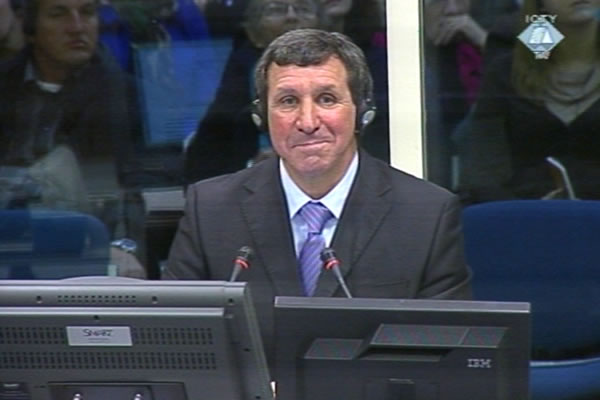Home
COLONEL DEMURENKO'S PRIVATE INVESTIGATION OF MARKALE MASSACRE
Through his first witness, Russian colonel Andrej Demurenko, Radovan Karadzic tried to corroborate his claim that the Markale incident on 28 August 1995 'was shamelessly staged'. A total of 43 people were killed and 75 were wounded in the incident
 Andrej Demurenko, defence witness of Radovan Karadzic
Andrej Demurenko, defence witness of Radovan Karadzic Through his first witness, Russian colonel Andrej Demurenko, Radovan Karadzic tried to bolster his argument that the Markale market incident on 28 August 1995 was 'shamelessly staged', as Karadzic put it in his introductory statement. Forty-three citizens of Sarajevo were killed and 75 were wounded in the incident. As Karadzic said, 'there was an explosion' and 'some people were killed' but the bodies of persons who had been killed elsewhere were brought to the town market to 'magnify the disaster and multiply the images of suffering'.
In the written statement ha gave to Karadzic's defense, Demurenko described how the UNPROFOR's official report which stated that the Serb side was responsible for the shelling of Markale market 'provoked' him to conduct his own private investigation of the incident. It took Karadzic half an hour to read the summary of the witness's statement in court. According to the summary, Demurenko 'gathered a group of experts' and together they visited locations along the line from which the shell could have been fired. Demurenko 'established' that the shell 'could not have been fired from the Bosnian Serb positions' and concluded that it was an 'act of terrorism'.
Karadzic played a video in which Demurenko - 'as a citizen of his country' and a 'military professional' - says he visited locations on the Serb side from which the shell could have been fired. The locations were too steep, too rocky or densely wooded for mortars to be positioned there, and there was no evidence that any mortar shells had been fired from there.
At the beginning of the cross-examination, prosecutor Alan Tieger put it to Demurenko that he had drawn an erroneous conclusion because he had gone to wrong locations. The prosecutor argued that when Demurenko was trying to determine the possible sites, he was using findings of the French military engineers and then applied the Russian firing tables instead of using NATO tables the French had worked with. Demurenko agreed that there were differences in the system of calculating the angles of descent but noted that 17 years ago it would be hard for him to imagine he would one day be sitting in a courtroom discussing the application of various tables.
The prosecutor went on to note that the Trial Chamber in the case against former commander of the Sarajevo-Romanija Corps Dragomir Milosevic dismissed Demurenko's evidence about the Markale incident. The Trial Chamber concluded that Demurenko and his team investigated only an area of 10 to 15 meters around the sites that the shell could have been fired from. The ‘margin of error’ covered a much wider area, the Trial Chamber found. This time, the witness said he had examined 'thousands of square meters' along the possible line of fire. The witness also repeated he was 'strongly convinced' that there was no shell and that it was an 'act of terrorism' in Sarajevo.
The prosecutor also noted that in his written statement the witness stated the Trial Chamber in Milosevic’s case 'mixed up' two different margins of error. Asked what he meant by that, Demurenko refused to reply either to the prosecutor or to the judges. He justified his refusal by saying it was not up to him to comment on the findings of the Trial Chamber. It was difficult for him to say what the Trial Chamber based its conclusions on, Demurenko noted. The prosecution will continue cross-examining Demurenko tomorrow.
Linked Reports
- Case : Karadzic
- 2012-10-12 KARADZIC ASKS FOR MORE TIME
- 2012-10-11 KARADZIC GETS A BILL FROM TRIBUNAL
- 2012-10-05 KARADZIC GRANTED LEAVE TO APPEAL
- 2012-10-17 DEMURENKO DENIES HE ENJOYED SPECIAL TREATMENT FROM VRS
- 2012-10-17 KARADZIC 'AMENDS' WITNESS'S STATEMENTS
- 2012-10-18 DENYING SNIPER AND ARTILLERY TERROR IN SARAJEVO
